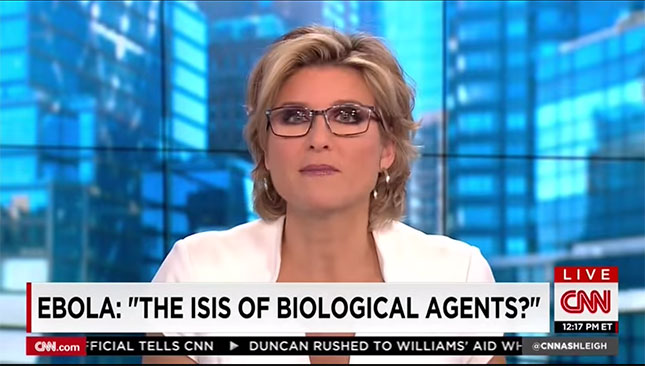
Network news coverage of the Ebola virus abruptly and dramatically fell off following the midterm elections earlier this month, according to a new study by media watchdog group Media Matters for America.
After reviewing transcripts from Oct. 7 to Nov. 17 in the 5-11 p.m. time slot, Media Matters discovered that evening broadcast and cable news programs aired close to 1,000 segments on Ebola in the four weeks leading up to the elections, and only 49 segments in the two weeks that followed.
“In early October, the GOP developed a plan to make the federal government’s response to Ebola a central part of its midterm elections strategy,” the study reads. “Television media played into Republicans’ hands, helping to foment panic about the disease.”
GOP candidates sought to make “question of how safe we are,” including from Ebola, a primary focus of their campaigns, wrote Jeremy Peters in an October 9 New York Times article. “Republicans believe they have found the sentiment that will tie congressional races together with a single national theme…”
Demonstrating the GOP’s fear-based campaign strategy, the Hill reports that political ads mentioning Ebola aired an average of six times per hour in the week before the election in swing states. In one four-day stretch, between Oct. 21 and Oct. 25, Ebola was featured in no fewer than 734 political ads.
But as the new Media Matters report shows, the culmination of midterm elections not only brought an abrupt end to campaign ads, but also to coverage of Ebola in U.S. news media.
CNN showed the most significant decrease in Ebola coverage following the midterms, airing 335 segments in the weeks leading up to Election Day and just 10 in the period after. Fox News’ coverage fell from 281 segments to 10, and MSNBC recorded a disparity of 222 segments to 13.
Broadcast networks showed a pronounced dip in their Ebola coverage as well. “CBS’ 54 segments dropped to six, NBC’s 44 segments dropped to five, and ABC’s 39 segments dropped to four,” according to the study.
Skewed coverage overlooks real Ebola crisis
Even before the compilation of this data — before the correlation between Ebola and the midterm elections became so clear — the media faced harsh criticism for the fervor and panic with which it reported on a virus that had only infected, at most, a handful of U.S. citizens.
In October, Fox News’ Shepard Smith scolded his colleagues in for their “irresponsible” and “hysterical”  handling of the story. Also condemning Fox News’ sensationalism was PBS science correspondent Miles O’Brien, who said the network’s coverage “reflects a level of ignorance which we should not allow in our media.”
handling of the story. Also condemning Fox News’ sensationalism was PBS science correspondent Miles O’Brien, who said the network’s coverage “reflects a level of ignorance which we should not allow in our media.”
Meanwhile, notes Media Matters, USA Today columnist Rem Rieder called the “breathless, alarmist reports” on Ebola “the antithesis of what responsible journalists should be doing,” in a piece published a week prior to the midterms.
From Newsweek putting a monkey on the cover of their magazine titled “A Backdoor To Ebola: Smuggled Bushmeat Could Spark A U.S. Epidemic,” to Dr. Sanjay Gupta pouring chocolate sauce on himself live on CNN to show “how easy” it is to contract the disease, mainstream news outlets have truly demonstrated that their primary goal is to gain viewers, rather than report the facts.
And despite all the reports and panels, and the hours upon hours of segments leading up to Election Day, the coverage was still rife with misinformation and largely incomplete. News outlets obsessively scrutinized the handling of few isolated cases of Ebola within the U.S. while all but ignoring the thousands dying from the disease at the source of the outbreak.
“If poor media coverage can create an atmosphere of anxiety and misinformation, then the right kind of coverage can lead to a more active and productive public response,” Jason Linkins wrote for The Huffington Post in October. “To achieve this, the media needs to recognize that the true center of gravity in the Ebola story is the crisis in West Africa.”
